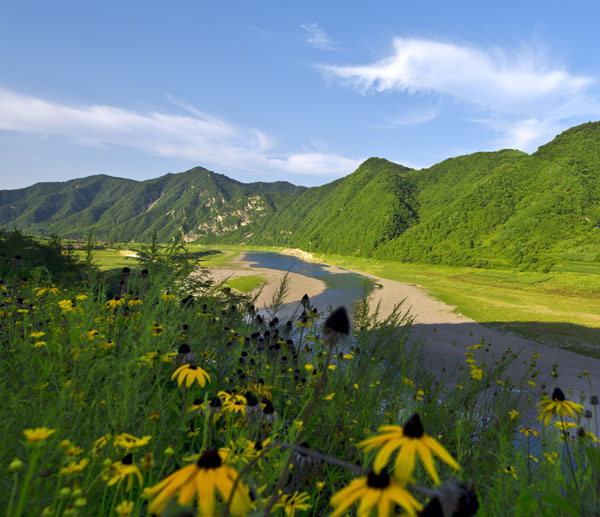


The city of Dandong, with an unspoiled ecosystem and vast intertidal mudflats, offers a perfect stopover for migratory birds. [Photo/China Daily]
The spectacle brought 37,000 naturalists last year.
Roads to the oceanfront meander through desolate kilometers of shipyards and fish farms. They're lined with abandoned boats. Marooned ghost ships, the absence of residents and the mist, all conspire to create an otherworldly ambiance.
The ocean swarms with seafood made delectable by the cold.
And the Yalu River that empties into the sea brims with some 88 fish species.
Demand for the local Shenxian-yuan baijiu (Chinese white liquor) springs from Dandong's water quality. Visitors to the AAAA-rated Tianqiao Gully National Forest Park can tour its plant, where the spirit is made using traditional processes in ancient-style buildings at the foot of the mountain range.
The location is touted as an "oxygen bar" nurtured by the exhalations of bonsai-like maples that cling to crags and entice autumn crowds. Some locals say that chain smokers don't cough there.
It was preserved as the Qing Dynasty (1644-1911) imperial hunting grounds. Ski runs and a lodge were completed a year ago.
Rustic farmhouses exude cornfields as they clamber up slopes and pack the cracks between peaks.
It's a similar panorama at the Fenghuang, or Phoenix, Mountain, where hillside hamlets prelude protruding peaks clutched by gnarled pines punctuated by ancient edifices.
Ecology encounters history at Fenghuang, whose appellation hails from a legend involving Tang Dynasty (AD 618-907) emperor Li Shimin.
The highlands were known as the Black Bone or the Bear Mountains until a general saw an owl swoop from a cave-an ominous omen. So the emperor visited. He instead saw two phoenixes flutter from the cavern-an auspicious totem.Ancient buildings testify to the mountains' position as various faiths' place of pilgrimage.
The Three-Religion Pavilion, for instance, affirms to its importance to Buddhism, Confucianism and Taoism. The structure stands uphill from a still-operational ancient Taoist center and Buddhist temple.
Only the fittest hikers can conquer the tough, final slog to Fenghuang's 836-meter-high apex within a day.
A stretch that makes the trek physically easier but psychologically harrowing is a glass platform soaring hundreds of meters in the air. (Seriously, don't look down.)
Fenghuang's topography is anthropomorphically rendered as Buddha statues, dragons and turtles, with a folktale to explain each shape.
So are the summits of Dandong's Hushan (Tiger Mountain), so named because it resembles a crouching tiger upon which rode Buddhism's goddess of mercy, Guanyin. She's also silhouetted as a nearby mount.
The Ming Dynasty (1368-1644) Great Wall's easternmost endpoint crowns Hushan. Dandong' surviving 2-km stretch of the bulwark peaks at 146 meters high.
Given Dandong's ecological offerings, the colorful concept of "come for the red, stay for the green" may just be the city's golden tourism ticket.
 |
 J-11 fighters in air exercise
J-11 fighters in air exercise Beauties dancing on the rings
Beauties dancing on the rings Attendants-to-be join Mr. & Miss Campus Contest
Attendants-to-be join Mr. & Miss Campus Contest Beijing's toughest anti-smoking law takes effect
Beijing's toughest anti-smoking law takes effect Family lives in cave for about 50 years in SW China
Family lives in cave for about 50 years in SW China PLA soldiers operating vehicle-mounted guns in drill
PLA soldiers operating vehicle-mounted guns in drill Blind carpenter in E China's Jiangxi
Blind carpenter in E China's Jiangxi China hosts overseas disaster relief exercise for the first time
China hosts overseas disaster relief exercise for the first time 20 pairs of twins who will become flight attendants in Sichuan
20 pairs of twins who will become flight attendants in Sichuan Obama is sowing discontent in S.China Sea
Obama is sowing discontent in S.China Sea Rescuers work through night to reach cruise ship survivors
Rescuers work through night to reach cruise ship survivors Driving through limbo
Driving through limbo Facing down MERS
Facing down MERSDay|Week